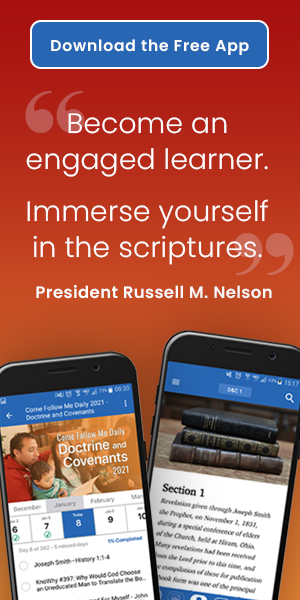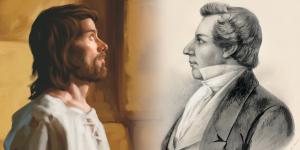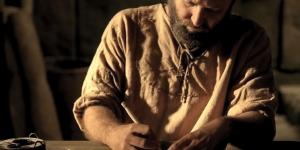You are here
What Can We Learn from 10 of the Best Chiasms in the Book of Mormon? Part 3

Alma 36:18
Editor’s Note: This is part our on-going series on chiasmus, in celebration of the 50th anniversary of its discovery in the Book of Mormon. Be sure to check out our other KnoWhys on chiasmus and the Chiasmus Resources website for more information.
In the last fifty years, hundreds of chiasms from the Book of Mormon have been proposed and studied.1 As John W. Welch noted in 1995, there are “varying degrees of chiasticity,” and while “many proposed chiasms are impressive and interesting; others appear to be contrived or unremarkable.”2 In other words, not all chiasms are created equal.
So to celebrate the discovery of chiasmus fifty years ago, we at Book of Mormon Central present 10 of the most interesting chiasms in the Book of Mormon. Seven were presented over the last two weeks,3 and now we present the final three. Each one is interesting for different reasons. Some are impressive for their display of artistry and creativity, others are important for the doctrinal truths they help to teach, clarify, or emphasize, while yet others are significant because of ancient Hebrew or Mayan connections.
Readers are invited to evaluate these chiasms themselves utilizing the criteria discussed previously.4
1 Nephi 4:4–27
The Know
Nephi’s use of chiasmus “is that of a sophisticated literary technician.”5 One of the most chiastic sections of Nephi’s writings is the brass plates narrative. A chiastic pattern for all of 1 Nephi 3–5 has been proposed,6 and nine other chiasms have been found throughout this story.7 Of those, this is the longest and most complex, and it encompasses the most central event of the brass plates narrative: killing Laban and getting the plates.
The Why
The turning point to the story comes as Nephi realizes the need to have the plates for his posterity to keep the commandments (1 Nephi 4:14–15), and this comes at the center of the chiastic structure. The Lord’s commandments are also a central theme of the entire brass plates narrative, and command or commandments get repeated 18 times throughout 1 Nephi 3–5.8 John W. Welch has also illustrated that this story was actually a carefully written legal argument,9 and that chiasmus played an important role in biblical legal texts.10
Chiastic Structure of 1 Nephi 4:4–27 |
|||||||
|
A |
nevertheless they did follow me up until we came without the walls of Jerusalem. … and I caused that they should hide themselves without the walls. (v. 4–5) |
||||||
|
|
B |
I, Nephi, crept into the city and went forth towards the house of Laban. … as I came near unto the house of Laban I beheld a man … it was Laban. (v. 5–8) |
|||||
|
|
|
C |
I beheld his sword, and I drew it forth from the sheath thereof (v. 9) |
||||
|
|
|
|
D |
I was constrained by the Spirit that I should kill Laban. … And the Spirit said unto me again: (v. 10–11) |
|||
|
|
|
|
|
E |
Behold the Lord hath delivered him into thy hands. … Slay him, for the Lord hath delivered him into thy hands. (v. 11–12) |
||
|
|
|
|
|
|
F |
It is better that one man should perish than that a nation should dwindle and perish in unbelief. (v. 13) |
|
|
|
|
|
|
|
|
G |
Inasmuch as thy seed shall keep my commandments, they shall prosper in the land of promise. (v. 14) |
|
|
|
|
|
|
|
G |
Yea, and I also thought that they could not keep the commandments of the Lord … save they should have the law. (v. 15) |
|
|
|
|
|
|
F |
And I also knew that the law was engraven upon the plates of brass. (v. 16) |
|
|
|
|
|
|
E |
I knew that the Lord had delivered Laban into my hands for this cause (v. 17) |
||
|
|
|
|
D |
Therefore I did obey the voice of the Spirit (v. 18) |
|||
|
|
|
C |
and I smote off his head with his own sword. … I had smitten off his head with his own sword (v. 18–19) |
||||
|
|
B |
I took the garments of Laban … went forth unto the treasury of Laban … I saw the servant of Laban … in the voice of Laban … his master, Laban … as if it had been Laban. (v. 19–23) |
|||||
|
A |
to my elder brethren, who were without the walls. … who were without the walls. (v. 24, 27) |
||||||
1 Nephi (whole book)
The Know
Nowhere is Nephi’s literary skill more clearly on display than in the expansive chiastic structure of the entire book of 1 Nephi. John W. Welch has explained that both 1 and 2 Nephi “are independent chiastic units, centrally focused and symmetrically organized,”11 but 1 Nephi is the more elaborate of the two. In 1 Nephi, “almost every element in the first half of the book” has “a specific counterpart in the second half.”12 Lehi’s and Nephi’s visions of the tree of life form “the central section of the book,”13 with Nephi’s encounter with the Spirt marking the very center.
The Why
Recognizing the book-length chiastic patterns in the Book of Mormon helps explain some of the more unusual features of the book’s organization.14 In the case of 1 and 2 Nephi, it “explains why Nephi divided his writings into two books.”15 Since Nephi was making a political argument in his small plates record,16 the placement of his vision at the very center would suggest that “experiencing the same vision as his father Lehi … [was] the decisive factor which in Nephi’s mind ultimately established him as the successor to his father.”17
Chiastic Structure of 1 Nephi |
|||||||||||
|
A |
Lehi prophesies warnings of destruction to the Jews and foresees the mercy of God (Chapter 1) |
||||||||||
|
|
B |
Lehi’s group departs from Jerusalem (2:2–15) |
|||||||||
|
|
|
C |
Nephi establishes himself over his brothers by obtaining the Plates of Brass (2:16–4:38) |
||||||||
|
|
|
|
D |
The sword of fine steel (4:9) |
|||||||
|
|
|
|
|
E |
Sariah’s concern (5:1–9) |
||||||
|
|
|
|
|
|
F |
The Plates of Brass as a guide (5:10–6:6) |
|||||
|
|
|
|
|
|
|
G |
The sons of Lehi get the daughters of Ishmael and Ishmael joins the group (7:1–5, 22) |
||||
|
|
|
|
|
|
|
|
H |
Nephi bound with cords in the wilderness (7:6–21) |
|||
|
|
|
|
|
|
|
|
|
I |
Lehi’s vision of the Tree of Life (8:1–38) |
||
|
|
|
|
|
|
|
|
|
|
J |
Lehi prophesies about the Old World and about the coming of the Lamb (10:1–22) |
|
|
|
|
|
|
|
|
|
|
|
|
K |
Nephi and the Spirit of the Lord (11:1–36) |
|
|
|
|
|
|
|
|
|
|
J |
Nephi prophesies about the New World and the coming of the Lamb (12:1–14:30) |
|
|
|
|
|
|
|
|
|
|
I |
Lehi’s vision of the Tree of Life interpreted (15:1–36) |
||
|
|
|
|
|
|
|
G |
The sons of Lehi marry the daughters of Ishmael and Ishmael dies (16:1–8, 34–35) |
||||
|
|
|
|
|
|
F |
The Brass Ball as a guide (16:9–17, 26–33) |
|||||
|
|
|
|
D |
The bow of fine steel (16:18) |
|||||||
|
|
|
C |
Nephi establishes himself over his brothers by building a ship (17:1–18:4) (3:7; cf. 17:3) |
||||||||
|
|
|
|
|
|
|
|
H |
Nephi bound with cords on the ship (18:11–16, 20–21) |
|||
|
|
|
|
|
E |
Sariah’s afflictions (18:17–19) |
||||||
|
|
B |
Lehi’s group arrives at the Promised Land (18:23–25) |
|||||||||
|
A |
Nephi prophesies concerning the fate of the Jews and concerning the mercy of the Lord unto the afflicted (chapters 19–22) |
||||||||||
Alma 36
The Know
Over the last fifty years, Alma 36 has, by far, been the most celebrated and studied example of chiasmus in the Book of Mormon.18 Statistically, it’s the strongest example of chiasmus in the entire Book of Mormon, having a 99.98% certainty that the chiastic pattern did not occur by chance.19 The chiastic structure “powerfully communicates Alma’s personal experience,” with “the central turning point of his conversion” coming “precisely when he called upon the name Jesus Christ.”20
The Why
Grant Hardy found that “the order and purposeful design of Alma 36 suggests a world in which God … is in control.”21 As someone who has literally studied hundreds of chiasms in literature spanning across millennia and cultures worldwide, John W. Welch said that Alma 36 “ranks as one of the best uses of chiasmus one can imagine.”22 Its literary power and elegance compelled prominent biblical scholar David Noel Freedman to say, “Mormons are very lucky. Their book is very beautiful.”23
So there you have it—10 of the most interesting chiasms found in the Book of Mormon. Which was your favorite? While these may not definitively be the top 10—there are many more examples of compelling and significant chiastic patterns in the Book of Mormon—they provide a representative sample of Book of Mormon chiasms.
These 10 chiasms illustrate the variety, creativity, beauty, artistry, complexity, and overall significance of the Book of Mormon’s use of chiasmus. Indeed, as Freedman described it, the Book of Mormon is a very beautiful book.
Further Reading
Donald W. Parry, Poetic Parallelisms in the Book of Mormon: The Complete Text Reformatted (Provo, UT: Neal A. Maxwell Institute for Religious Scholarship, 2007).
John W. Welch, “What Does Chiasmus in the Book of Mormon Prove?” in Book of Mormon Authorship Revisited: The Evidence for Ancient Origins, ed. Noel B. Reynolds (Provo, UT: FARMS, 1997),
John W. Welch, “Chiasmus in the Book of Mormon,” in Book of Mormon Authorship: New Light on Ancient Origins, ed. Noel B. Reynolds (Provo, UT: Religious Studies Center, Brigham Young University, 1982; reprint FARMS, 1996),
- 1. “Chiasmus Index: Book of Mormon,” at Chiasmus Resources; Donald W. Parry, Poetic Parallelisms in the Book of Mormon: The Complete Text Reformatted (Provo, UT: Neal A. Maxwell Institute for Religious Scholarship, 2007).
- 2. John W. Welch, “Criteria for Identifying and Evaluating the Presence of Chiasmus,” Journal of Book of Mormon Studies 4, no. 2 (1995): 14, 13, capitalization altered.
- 3. See Book of Mormon Central, “What Can We Learn from 10 of the Best Chiasms in the Book of Mormon? Part 1,” KnoWhy 349 (August 7, 2017); Book of Mormon Central, “What Can We Learn from 10 of the Best Chiasms in the Book of Mormon? Part 2,” KnoWhy 352 (August 14, 2017).
- 4. See Book of Mormon Central, “What Counts as Chiasmus? (1 Nephi 19:7),” KnoWhy 337 (July 10, 2017).
- 5. John W. Welch, “Chiasmus in the Book of Mormon,” in Chiasmus in Antiquity: Structures, Analyses, Exegesis, ed. John W. Welch (Hildesheim, GER: Gerstenberg Verlag, 1981; reprint Provo, UT: Research Press, 1999), 199.
- 6. Noel B. Reynolds, “The Political Dimension in Nephi’s Small Plates,” BYU Studies 27, no. 4 (Fall 1987): 23.
- 7. See all nine chiasms in Donald W. Parry, Poetic Parallelisms in the Book of Mormon: The Complete Text Reformatted (Provo, UT: Neal A. Maxwell Institute for Religious Scholarship, 2007), 5–12. Six of the chiasms in this portion of Nephi’s record are evaluated based on both statistical and subjective criteria in Dennis Newton, “Nephi’s Use of Inverted Parallels,” Interpreter: A Journal of Mormon Scripture 22 (2016): 79–106. Of the chiasms from 1 Nephi 3–5, only one (1 Nephi 5:1–6) was deemed “not likely” to be intentional (p. 91, fig. 4). In contrast, the intentionality of the chiastic structure in 1 Nephi 4:5–24 was judged to be “probable.”
- 8. Joseph Spencer, An Other Testament: On Typology, 2nd edition (Provo, UT: Neal A. Maxwell Institute for Religious Scholarship, 2016), 84–90. On the frequency of command or commandment, see 1 Nephi 3:2, 4, 5, 7 (3x), 15, 16 (2x), 18, 21; 4:1, 11, 15, 17, 20, 34.
- 9. John W. Welch, “Legal Perspectives on the Slaying of Laban,” Journal of Book of Mormon Studies 1, no. 1 (1992): 119–141.
- 10. John W. Welch, “Chiasmus in Biblical Law: An Approach to the Structure of Legal Texts in the Hebrew Bible,” Jewish Law Association Studies 4 (1990): 5–22.
- 11. Welch, “Chiasmus in the Book of Mormon,” (1981), 199.
- 12. Welch, “Chiasmus in the Book of Mormon,” (1981), 199.
- 13. Welch, “Chiasmus in the Book of Mormon,” (1981), 199.
- 14. John W. Welch, “Chiasmus in the Book of Mormon,” in Book of Mormon Authorship: New Light on Ancient Origins, ed. Noel B. Reynolds (Provo, UT: Religious Studies Center, Brigham Young University, 1982; reprint FARMS, 1996), 49.
- 15. Welch, “Chiasmus in the Book of Mormon,” (1981), 199.
- 16. Noel B. Reynolds, “Nephi’s Political Testament,” in Rediscovering the Book of Mormon: Insights You May Have Missed Before, ed. John L. Sorenson and Melvin J. Thorne (Salt Lake City and Provo, UT: Deseret Book and FARMS, 1991), 220–229; Noel B. Reynolds, “The Political Dimension in Nephi’s Small Plates,” BYU Studies 27, no. 4 (Fall 1987): 15–37.
- 17. Welch, “Chiasmus in the Book of Mormon,” (1981), 199.
- 18. John W. Welch, “Chiasmus in Alma 36,” FARMS Preliminary Report (1989); John W. Welch, “A Masterpiece: Alma 36,” in Rediscovering the Book of Mormon: Insights You May Have Missed Before, ed. John L. Sorenson and Melvin J. Thorne (Salt Lake City and Provo, UT: Deseret Book and FARMS, 1991), 114–131; Grant Hardy, Understanding the Book of Mormon: A Reader’s Guide (New York, NY: Oxford University Press, 2010), 137–142.
- 19. Boyd F. Edwards and W. Farrell Edwards, “Does Chiasmus Appear in the Book of Mormon by Chance?” BYU Studies 43, no. 2 (2004): 110, 121–123.
- 20. Welch, “A Masterpiece,” 118.
- 21. Hardy, Understanding the Book of Mormon, 140–141.
- 22. Welch, “A Masterpiece,” 131.
- 23. David Noel Freedman, as quoted in John W. Welch, “What Does Chiasmus in the Book of Mormon Prove?” in Book of Mormon Authorship Revisited: The Evidence for Ancient Origins, ed. Noel B. Reynolds (Provo, UT: FARMS, 1997), 206.
KnoWhy Citation
Related KnoWhys
Subscribe
Get the latest updates on Book of Mormon topics and research for free






